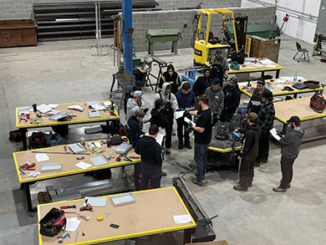
Brendan Talbot from Manufacturing Safety Alliance of BC shares top tips for emergency planning that is tailored to your business needs.
By / Jessica Kirby
As a business owner, you’re probably prepared for most things business-related: taking on new work, labour challenges, market fluctuations, maybe even succession planning. But what about emergencies? If you have a plan in place for earthquakes, floods, wildfires, or Mount Baker blowing its top, raise your hand … Anyone?

“I don’t think that businesses are generally prepared for emergencies, and those who are prepared are probably not prepared well enough,” says Brendan Talbot, safety advisor – specialist, occupational hygienist, Manufacturing Safety Alliance of BC. Talbot presented at a SMACNA-BC dinner meeting earlier this year, sharing a wealth of knowledge about how we are—and aren’t—prepared for the worst.
Over the last five years, Manufacturing Safety Alliance of BC has noticed an important trend. Despite general knowledge of the risks that come with not being prepared, business operators—and people in general—have largely failed to dedicate the time necessary to fully understand the impacts of climate emergencies and to develop response plans that sufficiently address them.
“The reoccurring wildfires—in particular those in 2021 and 2023—were big wake up calls for many people and businesses within the Interior,” Talbot says. “However, it’s not just businesses within the Interior that are not well prepared for climate crises. It’s also those in the Lower Mainland, on Vancouver Island, and everywhere throughout BC, really.”
As an example, how many within the Fraser Valley can say they were adequately prepared for the flooding of 2021?
It was after the wildfires in Kelowna that Manufacturing Safety Alliance of BC members began to reach out to the association looking for help with emergency response planning and training. Many were looking for help developing and implementing emergency response and business continuity plans, so that they could start conducting drills in advance of this year’s wildfire season, Talbot says.

It is often the case that environmental emergencies begin to really hit home once they occur close to home and the reality of what a disaster could do to a business or home sinks in.
“Now is the time for business operators to build out their emergency response plans,” Talbot says. “However, it’s not just environmental incidents like wildfires, floods, and earthquakes but also avalanches, extreme winds, and extreme rain. Companies also need to prepare for unnatural emergencies like power outages, equipment failures, or, if you’re near a railroad track or under a flight path, train derailments or plane crashes.”
If that all sounds heavy, it’s because it is—but there are steps business owners can take to get an emergency plan in place. “The number one thing to start with is a comprehensive risk assessment,” Talbot says. “I can’t stress that enough.”
That means a thorough review of your business to determine what you may have on site that could cause an issue. Do you store hazardous materials? Is there a risk of a catastrophic chemical spill or could compressed gas be released? What are the implications should a natural gas leak or power outage occur? Consider lead-up events that may cause or contribute to that event and what the consequences might be.
“Through planning for relatively small events that may impact a room or building, one area of your facility, or even the entire facility, you’re building a more robust and thorough response, which will help to control hazards during a bigger and more catastrophic emergency,” Talbot says. “So, start small.”
When performing the risk assessment, think of the worst-case scenario and consider your geographic location, the age and stability of your buildings, and when the last time your buildings were inspected.
“If you are near a river, what will you do if there is a flood or if the ground below you erodes?” Talbot asks. “In the Fraser Valley, we also need to think about our plans if a volcano erupts. We are close to Mount Baker in Washington, and if it erupts, an intense environmental disaster could result for people in the immediate area and, depending on wind direction, could impact those in Abbotsford and Chilliwack.”
The next step is knowing your capabilities and being aware of what tools and resources you have access to or can access quickly. For example, Talbot says, if there is a fire, every site or building will have some capability to fight a fire, however, some will have very significant fire suppression systems, while others do not. So, as you perform the risk assessment, consider how you can allocate budget towards building up those emergency response resources and procedures.
And whatever you do, don’t overlook the importance of running emergency response drills regularly. It may not be practical to conduct an emergency response drill for every possible emergency, but Talbot recommends picking two each year.
If a business doesn’t plan accordingly, the consequences can range from property damage to worker injury and even death, in the event inadequate resources exist or one’s ability to respond is inadequately assessed.
Inadequate response to an emergency can affect a business’s production capability, reputation, or long-term ability to operate, not to mention resulting in huge financial losses from which a company may not be able to recover.
“Essentially, inadequate planning leads to inadequate response, and during a time of emergency when challenges arise and unpredictability dominates, a well-constructed emergency response plan and comprehensive workforce training becomes invaluable,” Talbot says.
Your emergency plan will be unique to your business, so a good place to start is by reaching out to the Manufacturing Safety Alliance of BC. The team has decades of combined health and safety experience in various industries from manufacturing to construction to oil and gas.
“We can help tailor an emergency response plan that will meet each business’ specific needs,” Talbot says. “We also offer training in hazard identification and control, emergency response planning, and workplace inspections, which are all helpful tools for managing emergency response.” ■
Learn more at safetyalliancebc.ca
Connect | Facebook @safetyalliancebc
Instagram @manusafebc | X @manusafebc



